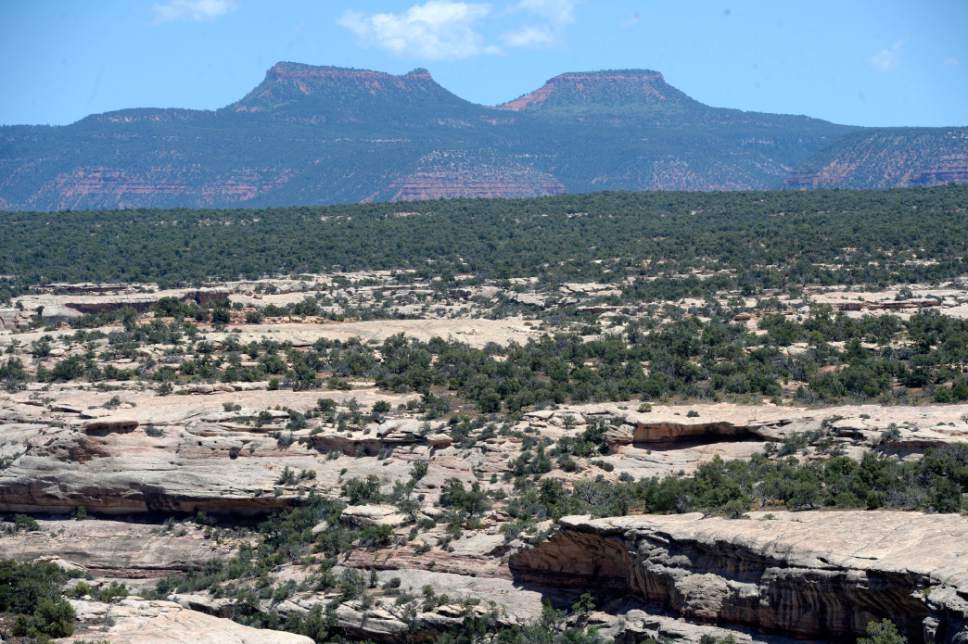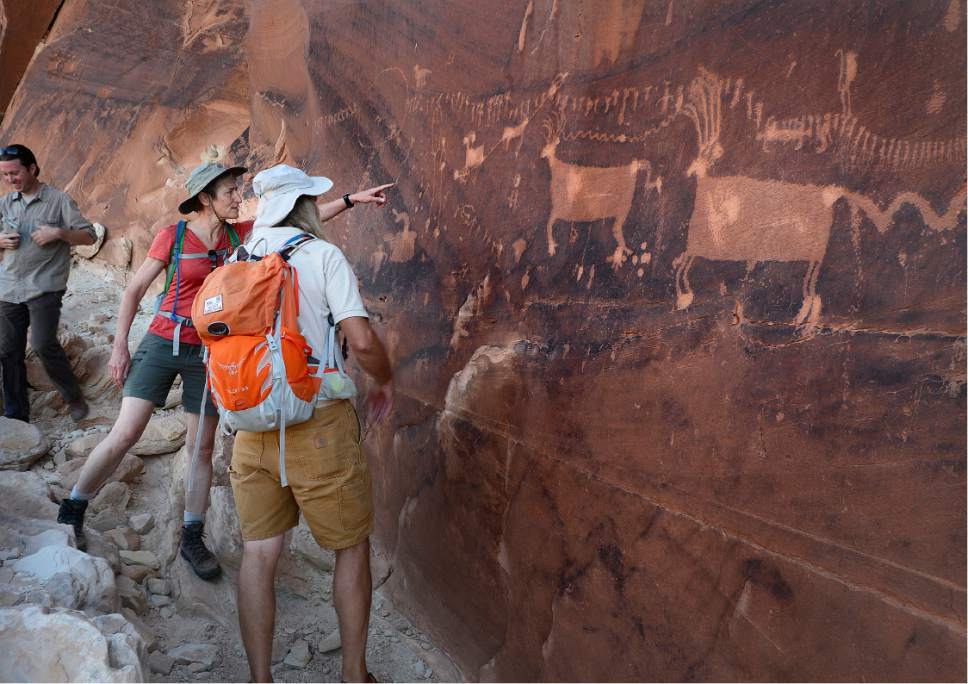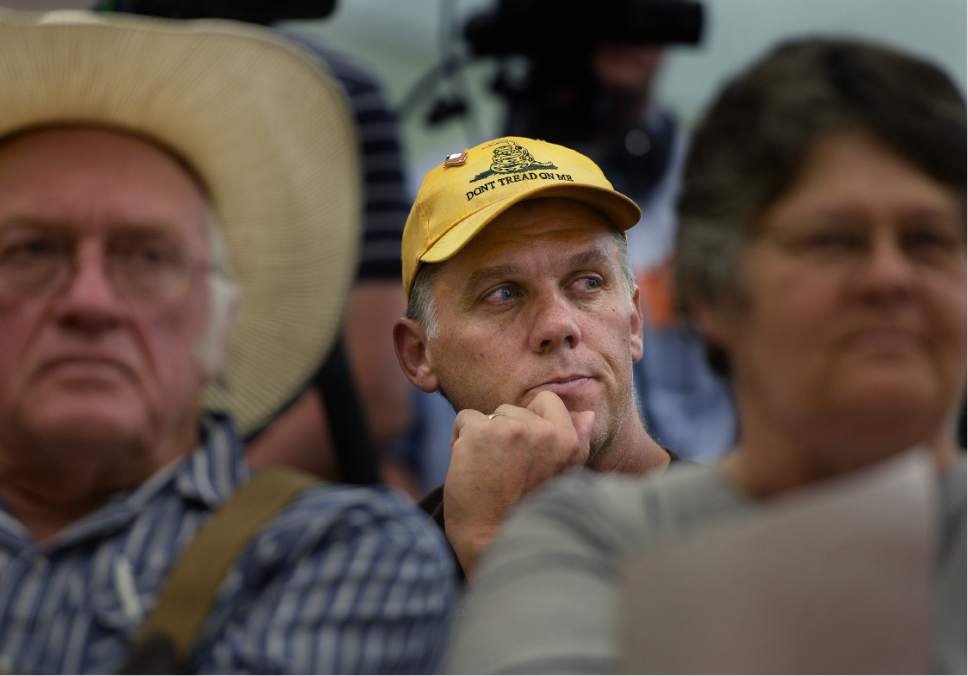This is an archived article that was published on sltrib.com in 2017, and information in the article may be outdated. It is provided only for personal research purposes and may not be reprinted.
Washington • The U.S. Interior Department and the National Park Service thought they had found an undeniable gem of treasured lands that deserved protection: redrock country rich with archaeological sites, centuries-old cultural ties and a uniqueness that had inspired Americans' love of Western vistas.
There was little private land involved, and with a few concessions to political leaders, the nation's land managers were hopeful that a proposed national monument would be met with open arms.
They were wrong.
That was some 81 years ago. Interior Secretary Harold Ickes' pitch to President Franklin Delano Roosevelt fell flat after Utah's governor and members of Congress — Democrats all — stood in lockstep to oppose a new Escalante National Monument in the southeastern corner of the state.
While there have been subsequent attempts to protect parts of the area — some successful, some not — President Barack Obama's designation last week of the 1.35 million-acre Bears Ears National Monument ended a multigenerational effort to preserve the land dotted with American Indian artifacts and sacred grounds.
But Obama's move also stokes a renewed fight between Westerners and Washington, one that isn't likely to end with the announcement and furthers disconnect among those who live in the monument's backyard, their elected leaders and those who see preservation as a vital and urgent need.
"It's definitely not the end. It may not even be the end of the beginning," said Boyd Matheson, president of the conservative Sutherland Institute and an opponent of the monument designation. "We may be a long way coming on this one. I think that's an important thing to keep in mind. It doesn't have to be the end that the environmental groups and those who were for it can spike the ball, nor does it have to be the end for those who were against it and want local control and feel like they've lost."
Already, Utah Attorney General Sean Reyes is threatening a lawsuit, and Rep. Jason Chaffetz, chairman of the House Oversight and Government Reform Committee, has threatened to issue subpoenas about the designation. Legislation to overturn the new monument is expected at the start of Congress' new session in January.
Utah officials engaged in a social-media campaign using the hashtag "NoMidnightMonument," but they couldn't have been surprised that Obama acted. He and other administration officials had long said more monuments would be coming.
"I've preserved more than 3 million acres of public lands for future generations. And I am not finished," Obama said in August 2014. The outgoing president's grand total now covers 553 million acres of protected land and water with 29 new or expanded monuments.
—
Enter the PLI • Rep. Rob Bishop, a Utah Republican whose biggest campaign contributors are from the oil and gas industry, had attempted to head off a monument designation beginning more than three years ago, starting a conversation among environmentalists, oil and gas companies, local officials and other interested parties to try to find a consensus on preservation and development.
"There is some land that needs to be preserved and there's nothing wrong with that," Bishop said in April 2013. "There's also land that needs to be developed, and there's no reason why the two can't coexist."
Bishop's office held scores of meetings to bring all sides to the table on that effort, though eventually tribal leaders withdrew from the process, saying their contributions had been ignored. They urged Obama to name a monument.
While Bishop, later joined by Chaffetz, looked at stitching together legislation to protect parts of the Bears Ears area, and opening up other sections to development, the Obama administration started taking its own deep look at what to do in southeastern Utah.
In July 2015, National Parks Service Director Jonathan Jarvis and other officials traveled to the Bears Ears region to huddle with tribal leaders who wanted to preserve the area. The Interior Department downplayed the meeting as a listening tour.
A senior White House official, who agreed only on condition of anonymity to discuss the background of the monument's designation, says that the administration tried to work with Utah's congressional delegation to find a path forward that worked for everyone.
"We said to the delegation from the very beginning, and this is true from the president's perspective, the first best option is the legislation because that allows all the parties to come together and figure out what works for them," the official said.
Interior Secretary Sally Jewell and other land-management leaders visited the Bears Ears region and held town-hall meetings to hear from residents and others about how best to preserve the area.
The visit coincided with the unveiling, after months of discussion, of Bishop's and Chaffetz's Public Lands Initiative (PLI), which would soon get a House hearing. Obama administration officials testified at that Natural Resources hearing that they supported the goal of the legislation but pointed out several worrisome provisions.
"We were very hopeful that the legislation would move in a form obviously that we could support," the senior White House official said last week. "That's not what happened at the end of the day."
The Obama administration worked to help craft changes to the PLI and "conversations were very active up and through the hearing that the delegation held," the official said.
But the bill didn't move forward in the House, and was never introduced in the Senate as Congress' final days ticked down.
—
Talk and action • Meanwhile, the White House began to draw up a monument designation as Utah elected leaders held news conferences and jumped on social-media channels to rally opposition to what they feared would come — and assumed was pretty much inevitable.
"If you abuse the Antiquities Act, Congress is going to take that power away from future presidents," Rep. Chris Stewart, R-Utah, threatened last month, referring to the 1906 law that gives a president unilateral power to preserve public lands as monuments.
White House officials, knowing that Obama's time in office was limited, decided to act in the past couple of weeks and whittled down the monument's size from what tribal leaders were asking — some 1.9 million acres — to mirror the size of the PLI, eventually designing the monument as 1.35 million acres. The goal was to find the areas of "greater consensus" to preserve, the White House official said. The president, vacationing in Hawaii, was not expected to visit the Bears Ears area because of time constraints and other obligations, the official added.
"No one can say that they were surprised by this," the official said. "The discussion has been really robust."
Nevertheless, the monument announcement brought instant reminders to some Utahns of President Bill Clinton's use of the Antiquities Act to name the Grand Staircase-Escalante National Monument in southern Utah in 1996. That move covered some 1.8 million acres of public land and blocked a potential mining operation.
While polls have shown growing support for that monument in the two decades since it was established, it still doesn't sit well with some Utahns.
"I don't know anyone in Garfield County who is willing to put up a statue of Bill Clinton to go with his monument," said the Sutherland Institute's Matheson.
Still, more than eight decades after the idea of preserving the Bears Ears region was first discussed at the highest levels of government, Obama used his pen to create a monument, even if Utah leaders are now busy figuring out how to undo it.
No president has ever overturned a monument designation from a previous president (though some presidents have curtailed the size of established monuments).
And courts have consistently given the executive broad discretion with powers under the 1906 Antiquities Act, which contains no express authority for revoking a monument.
The administration was quick to point out that both Gov. Gary Herbert and Bishop have spoken publicly about the need to preserve some area around Bears Ears.
"Clearly, clearly there's a lot of politics around this one, but if you pull that aside and you push that way and you look at what people are saying and what they're talking about over the past few years, there was agreement about protecting Bears Ears. There was disagreement about how to do it," the senior White House official said, adding that the administration "did everything it could to give the [PLI] the greatest possibility" of success.
When that didn't happen, the official said, "that made it more likely the president would act absent action from Congress."
Herbert said he received a courtesy call from Jewell on Wednesday at 1:45 p.m. — a little more than an hour before the public announcement. The interior secretary agreed, he said, that protecting the area using legislation would have been preferable, but without such action a monument designation was necessary.
"I disagree," Herbert said.
Describing it as "a little bomb here in Utah," the governor said the monument "is really unnecessary other than to make a statement. I think the statement to be made is one of politics."
Herbert plans to join with other Utah elected officials and the incoming administration to explore all available "remedies."
— Lee Davidson contributed to this report.







